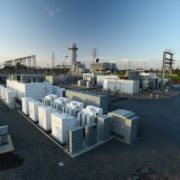One of the nation’s largest electric utilities, Southern California Edison (SCE), released on Tuesday, October 31, a strategic framework to help California meet climate and air quality goals by 2030.
“We are very committed to helping the state in its efforts to fight climate change and reduce air pollution,” said Pedro Pizarro, president and chief executive officer of Edison International, the parent company of SCE. The utility has a service area of around 50,000-square-miles within Central, Coastal, and Southern California.
The state of California has made greenhouse gas (GHG) goals for a 40 percent reduction in GHG emissions from 1990 levels by 2030, and an 80 percent reduction by 2050.
SCE looks to help California achieve those goals through its recently released white paper titled “The Clean Power and Electrification Pathway”.
In effort to continue carbon reduction in the electric sector — which SCE says now accounts for only 19 percent of California’s GHG emissions — the pathway works to double the use of carbon-free electricity from 40 percent to 80 percent by 2030. This includes increasing the use of large-scale, carbon-free energy generation through wind, solar, and large hydroelectric power plants, as well as through the continued use of rooftop solar energy.
The plan also looks to increase the number of electric vehicles (EV) on California roads. According to SCE, the transportation sector contributes close to 40 percent of the state’s GHG emissions, and 80 percent of California’s smog-forming nitrogen oxide (NOx) emissions.
“We believe that California will need to put out seven million or more personal electric vehicles by 2030,” said Pizarro.
Despite improvements in air quality awareness, many communities in California continue to experience asthma and other air-quality related issues. SCE advises that electrifying transportation is a much needed step in improving local air quality, especially in disadvantaged communities (DAC) that are disproportionately affected by pollution due to close proximity to heavily traveled highways.
Of the state’s DACs, nearly half fall into the utility’s service area.
To encourage EVs and consumer acceptance, particularly in the highly impacted DACs, the white paper urges to increase the amount of away-from-home charging ports, and continue financial incentives for EV purchases, especially for low- and middle-income communities.
Because many in DACs rely on public transportation, efforts to electrify medium and heavy duty vehicles like buses are also of focus.
“Buses are going to be a big part of the equation because they are particularly heavy emitters of air pollution and often, they’re working right in the middle of disadvantaged communities,” Pizarro told the Asian Journal.
“It might also be a great way to educate customers about electric transportation,“ he added. “If you’re taking a bus, you see it rides well, it’s clean, it’s quiet — it might also get consumer interest in passenger vehicles as well.”
Also part of the plan is the electrification of nearly one-third of residential and commercial space and water heaters by the 2030 mark. The building sector — which are residential, commercial, and industrial facilities combined — contributes approximately 30 percent of California’s GHG emissions according to SCE.
Cost concerns
SCE acknowledged that the cost of adapting clean power and electrification practices would be a concern for many communities, but affirmed that there would be no significant cost changes.
“We recognize, particularly with the customers that feel challenged to pay their bill, that they may have a lot of things on their plate and the last thing they want to think about is their electric bill and what they can do about it,“ said Caroline Choi, senior vice president of Regulatory Affairs for SCE.
About a third of SCE’s customers are on the utility’s income-qualified programs, she added.
Through the electrification pathway, SCE believes that the overall cost would not be profoundly affected.
“In the end result, we will see that the share of household incomes spent on all forms of energy won’t change when adjusted for inflation, so that’s good news,” explained Pizarro.
While consumers will see a roughly two percent increase per year, SCE assured that it would be offset by decreases of other energy sources like gasoline.
“So stands to reason if you’re using an electric car at home, you may be using more kilowatt hours, and you may have a higher electric bill due to that, but you also won’t be going to the pump,” said Pizarro. “So net — how much you’re spending on energy in total — we expect to not change very much,” he added.
Pizarro also clarified that SCE does not make money by selling electricity.
With twelve years to go until the 2030 target, SCE is pushing to encourage their pathway towards clean energy to all communities. This includes working with local community based organizations that respective community members trust and recognize, and providing information in different languages.
“Years in our world is a very short amount of time,” said Choi. “We’re talking about getting a lot of work done in a short period of time.”







